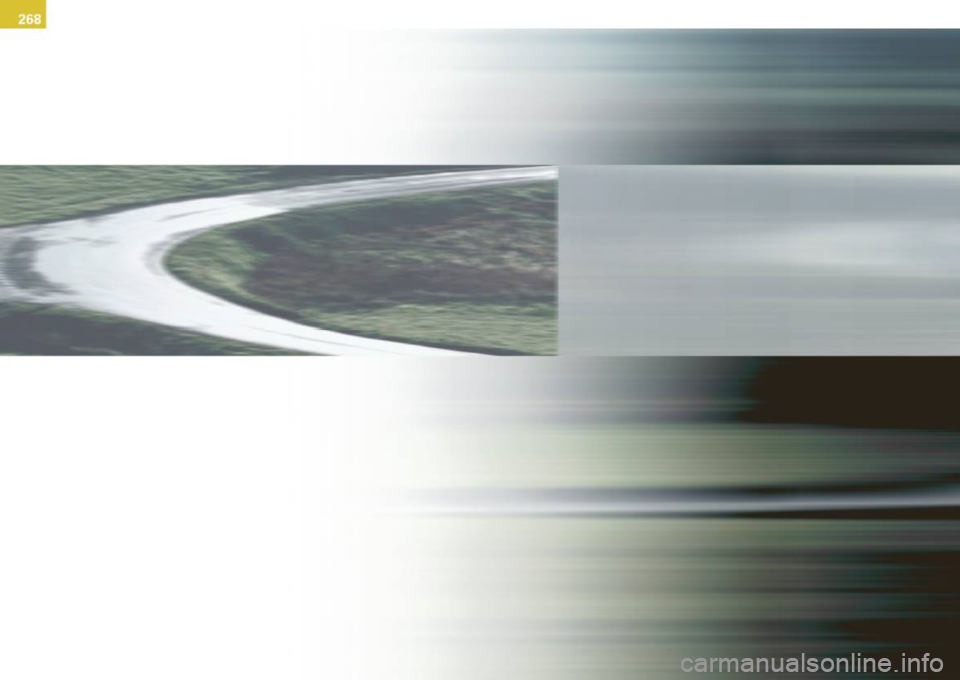AUDI S8 2009 Owners Manual
Manufacturer: AUDI, Model Year: 2009, Model line: S8, Model: AUDI S8 2009Pages: 408, PDF Size: 91.63 MB
Page 261 of 408
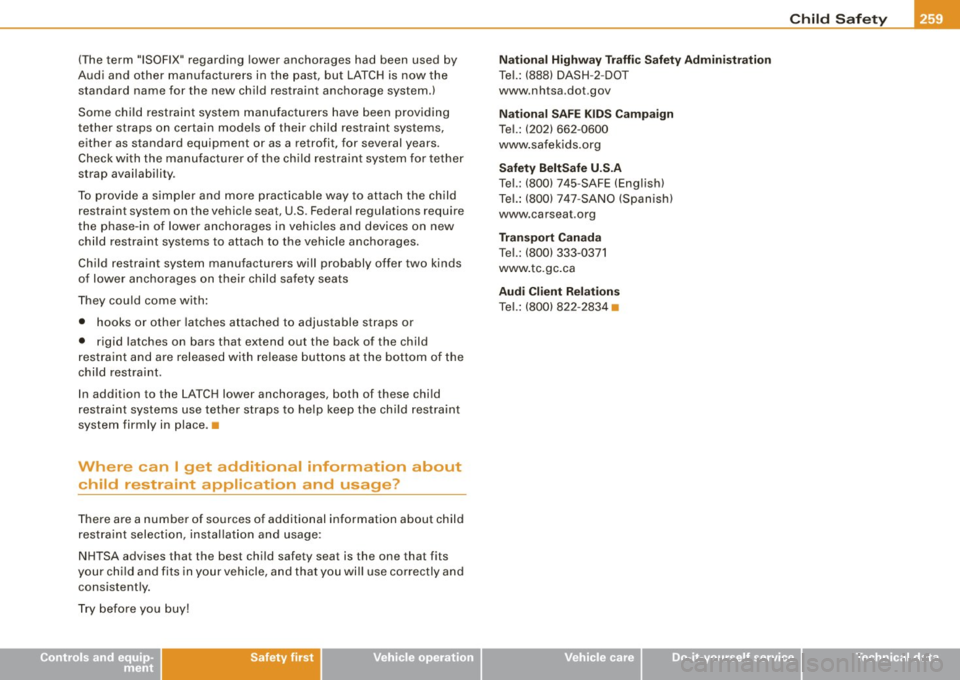
_______________________________________________ C_h _ i_ld _ S_ a_ f_ e_ t..,:c y __ ffl!III
(The term "ISOFIX" regarding lower anchorages had been used by
Audi and other manufacturers in the past, but LATCH is now the
standard name for the new child restraint anchorage system.)
Some child restraint system manufacturers have been providing
tether straps on certain models of their child restraint systems, either as standard equipment or as a retrofit, for several years .
Check with the manufacturer of the child restraint system for tether
strap availability .
To provide a simpler and more practicable way to attach the child
restraint system on the vehicle seat, U.S. Federal regulations require
the phase -in of lower anchorages in vehicles and devices on new
child restraint systems to attach to the vehicle anchorages.
Child restraint system manufacturers will probably offer two kinds
of lower anchorages on their child safety seats
They could come with:
• hooks or other latches attached to adjustable straps or
• rigid latches on bars that extend out the back of the child
restraint and are released with release buttons at the bottom of the
child restraint.
In addition to the LATCH lower anchorages, both of these child
restraint systems use tether straps to help keep the child restraint
system firmly in place .•
Where can I get additional information about
child restraint application and usage?
There are a number of sources of additional information about child
restraint selection, installation and usage :
NHTSA advises that the best child safety seat is the one that fits
your child and fits in your vehicle, and that you will use correctly and
consistently.
Try before you buy!
Controls and equip ment Safety first Vehicle operation National Highway Traffic Safety Administration
Tel.: (888) DASH -2 -DOT
www.nhtsa .dot .gov
National SAFE KIDS Campaign
Tel.: (202) 662 -0600
www.safekids.org
Safety BeltSafe U.S.A
Tel.: (800) 745-SAFE (English)
Tel.: (800) 747 -SANO (Spanish)
www.carseat .org
Transport Canada
Tel.: (800) 333-0371
www.tc.gc.ca
Audi Client Relations
Tel.: (800) 822-2834 •
Vehicle care Do-it-yourself service Technical data
Page 262 of 408
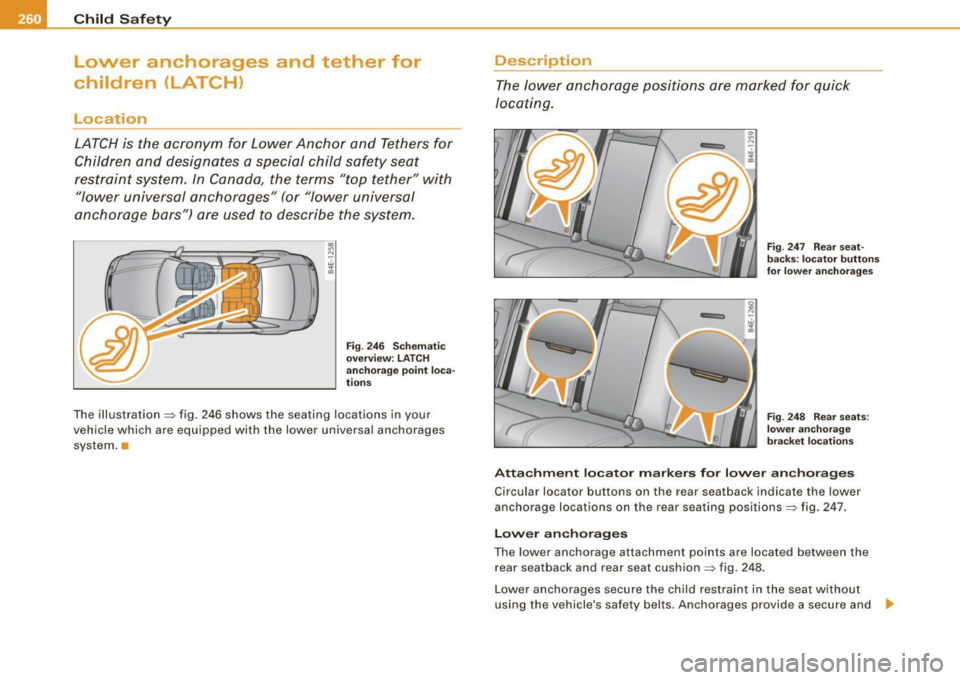
___ C_h_ i_ld _ S_ a_ f_ e_ t-= y'------------------------------------------------
Lower anchorages and tether for
children (LATCH)
Location
LATCH is the acronym for Lower Anchor and Tethers for
Children and designates a special child safety seat
restraint system. In Canada, the terms "top tether " with
"lower universal anchorages" (or "lower universal
anchorage bars") are used to describe the system.
Fig . 246 Schematic
overview: LATCH
anchorage point loca
tions
The illustration ~ fig. 246 shows the seating locations in your
vehicle which are equipped wi th the lower universal anchorages
system.
Description
The lower anchorage positions are marked for quick
locating.
Fig . 247 Rear seat
backs : locator buttons
for lower anchorages
Fig. 248 Rear seats:
lower anchorage
bracket locations
Attachment locator markers for lower anchorages
C ircular locator buttons on the rear seatback indicate the lower
anchorage locations on the rear seating positions~ fig. 247 .
Lower anchorages
The lower anchorage attachment points are located between the
rear seatback and rear seat cushion~ fig. 248.
Lower anchorages secure the child restraint in the seat without
using the vehicle 's safety belts . Anchorages provide a secure and
~
Page 263 of 408
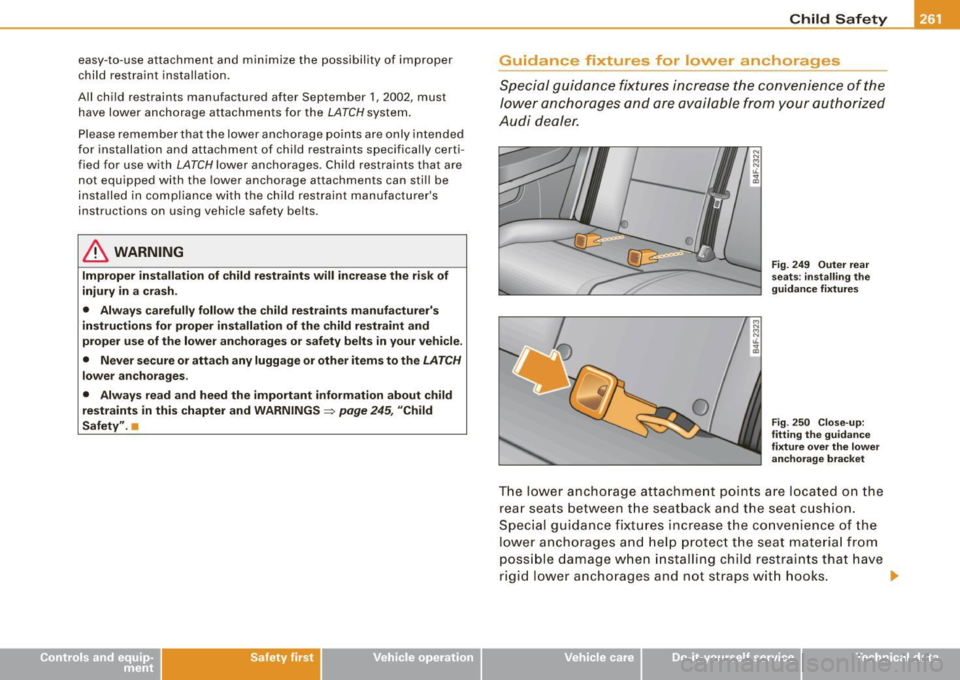
easy-to-use attachment and minimize the possibility of improper
child restraint installation.
All child restraints manufactured after September 1, 2002, must
have lower anchorage attachments for the LATCH system.
Please remember that the lower anchorage points are only intended
for installat ion and attachment of child restraints specifically certi
fied for use with LATCH lower anchorages. Child restraints that are
not equipped with the lower anchorage attachments can still be
installed in compliance with the child restraint manufacturer's
instructions on using vehicle safety belts.
& WARNING
Improper installation of child restraints will increase the risk of
injury in a crash.
• Always carefully follow the child restraints manufacturer's
instructions for proper installation of the child restraint and
proper use of the lower anchorages or safety belts in your vehicle.
• Never secure or attach any luggage or other items to the
LATCH
lower anchorages.
• Always read and heed the important information about child
restraints in this chapter and WARNINGS
=> page 245, "Child
Safety". •
Safety first
Child Safety
Guidance fixtures for lower anchorages Special guidance fixtures increase the convenience of the
lower anchorages and are available from your authorized
Audi dealer.
Fig . 249 Outer rear
seats : installing the
guidance fixtures
Fig . 250 Close-up:
fitting the guidance
fixture over the lower anchorage bracket
The lower anchorage attachment points are located on the
rear seats between the seatback and the seat cushion.
Special guidance fixtures increase the convenience of the
lower anchorages and help protect the seat material from
possible damage when installing child restraints that have
rigid lower anchorages and not straps with hooks. _,.
Vehicle care I I irechnical data
Page 264 of 408
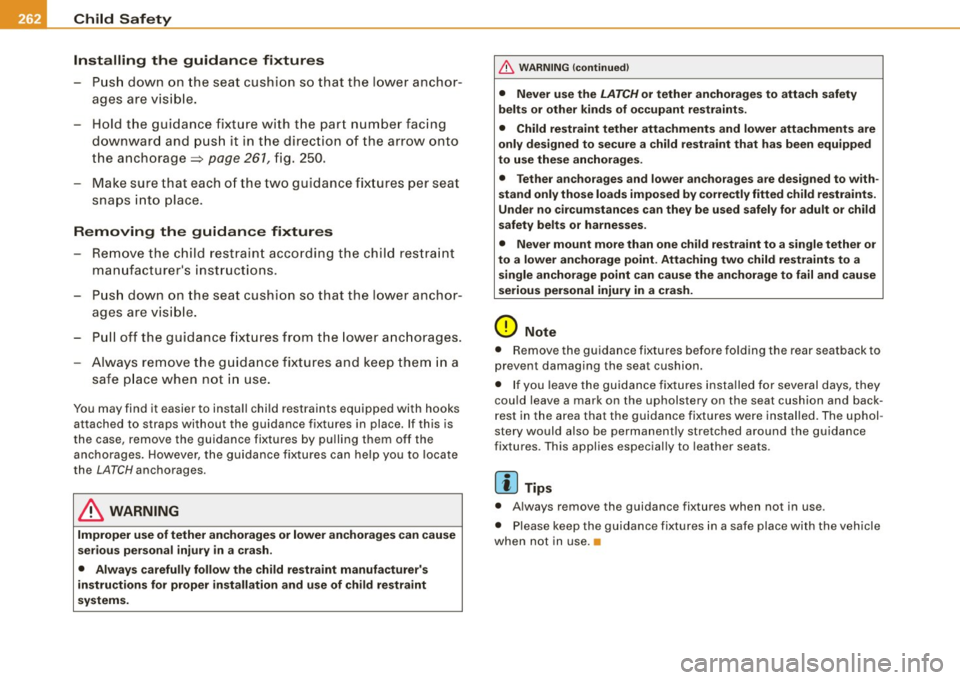
-L~C~h~ i~ ld ~ S~ a~ f~ e~ t:1Y :._ ___________________________________________ _
In stalling th e guidan ce fixtures
- Push down on the seat cushion so that the lower ancho r
ages are vis ible.
- Hold the guidance fixture with t he part number facing
downward and push it in the direction of the arrow onto
the anchorage =>
page 261, fig. 250.
- Make sure that each of the two guidance fixtures per seat snaps into place.
Removing the guidan ce fixtures
- Re move the child restrain t according the child res tra int
ma nufactur er's instr uct ions.
- Push down on the seat cushion so that the lower anchor
ages are visib le.
- Pu ll off the guidance fixtures from the lower a nch orages.
- Always remove the gu idance fixtures and keep them in a
safe p lace when not in use .
You may find it easier to insta ll child restraints equipped with hooks
attached to straps without the guidance fixtures in place . If this is
the case, remove the guidance fixtures by pu lling them off the
anchorages. However, the guidance fixtures can he lp you to locate
the LATCH anchorages.
& WARNING
Improp er use of tether anchorage s or lower anchorages can cau se
s erio us persona l inj ury i n a cra sh .
• Alway s carefully foll ow the child restraint manuf acturer's
in stru ction s fo r prope r inst allati on and use of child re str aint
sy stems .
& WARN ING (continued )
• Never use the LATCH or tether anchor ages to attach safety
belt s or ot her kinds of occupant re st raint s.
• Child restra int tether attachments and lower attachment s are
only de signed to se cure a child re straint that ha s been equipped
to use the se anchorages .
• Tether a nchorages and lower a nchorage s are desig ned t o with
s tand only those load s imposed by correctly fitted child re straint s.
Under no cir cum sta nce s ca n they be used safel y for adu lt or ch ild
s afety belts or harne sse s.
• Never mount more than one child r estraint to a single tether o r
to a lower an chorage point. Att aching two child restraints to a
s ingle anchorage point can ca use the anchor age to fail and cau se
s eri ous per sonal injury in a c rash .
0 Note
• Remove the guidance fixtures before fo lding the rear seatback to
prevent damaging the seat cushion.
• If you leave the guidance fixtures installed for several days, they
cou ld leave a mark on the upholstery on the seat cushion and back
rest in the area that the guidance fixtures were installed. The uphol
stery would also be permanent ly stretched around the guidance
fixtures . This applies especial ly to leather seats .
[ i ] Tip s
• Always remove the guidance fixtures when not in use.
• Please keep the guidance fixtures in a safe place with the vehicle
when not in use. •
Page 265 of 408
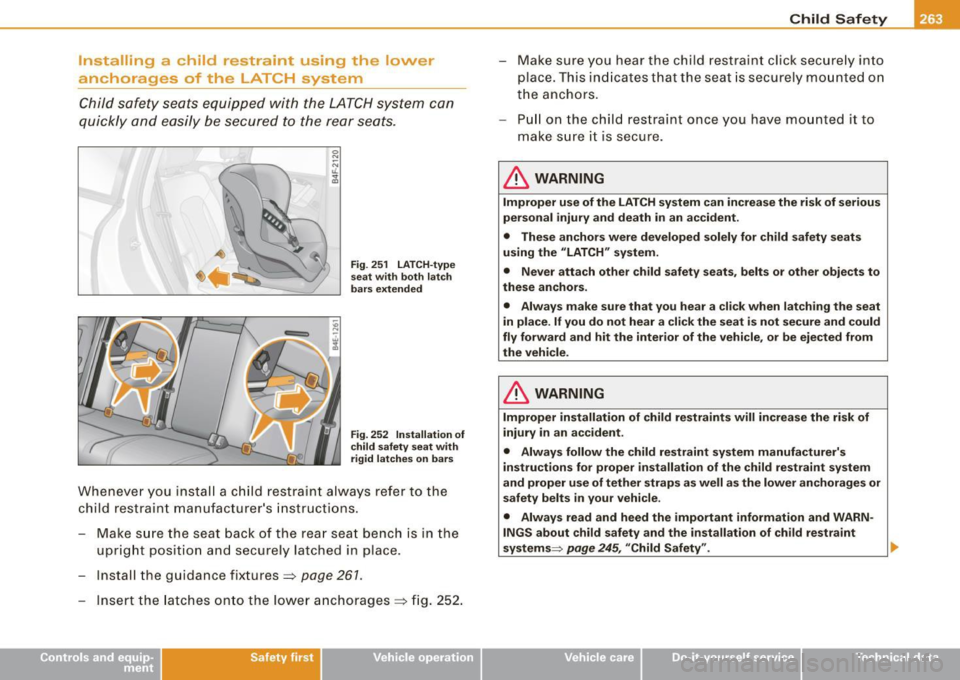
Installing a child restraint using the lower
anchorages of the LATC H system
Child safety seats equipped with the LATCH system can
quickly and easily be secured to the rear
seats.
0 N ;;; t1. ;g
Fig . 251 LATCH-type
seat with both latch
bars extended
Fig. 252 Installation of
child safety seat with
rigid latches on bars
Whenever you install a child restraint always refer to the
child restraint manufacturer's instructions.
- Make sure the seat back of the rear seat bench is in the
upright position and securely latched in place.
- Install the guidance fixtures=:>
page 261 .
-Insert the latches onto the lower anchorages==> fig. 252.
Safety first
Child Safety
- Make sure you hear the child restraint click securely into
place. This indicates that the seat is securely mounted on
the anchors.
- Pull on the child restraint once you have mounted it to
make sure it is secure.
& WARNING
Improper use of the LATCH system can increase the risk of serious
personal injury and death in an accident.
• These anchors were developed solely for child safety seats
using the "LATCH" system.
• Never attach other child safety seats, belts or other objects to
these anchors.
• Always make sure that you hear a click when latching the seat
in place . If you do not hear a click the seat is not secure and could
fly forward and hit the interior of the vehicle, or be ejected from
the vehicle .
& WARNING
Improper installation of child restraints will increase the risk of
injury in an accident .
• Always follow the child restraint system manufacturer's
instructions for proper installation of the child restraint system
and proper use of tether straps as well as the lower anchorages or
safety belts in your vehicle .
• Always read and heed the important information and WARN
INGS about child safety and the installation of child restraint
systems ~
page 245, "Child Safety". ...
I .
Vehicle care I • irechnical data
Page 266 of 408
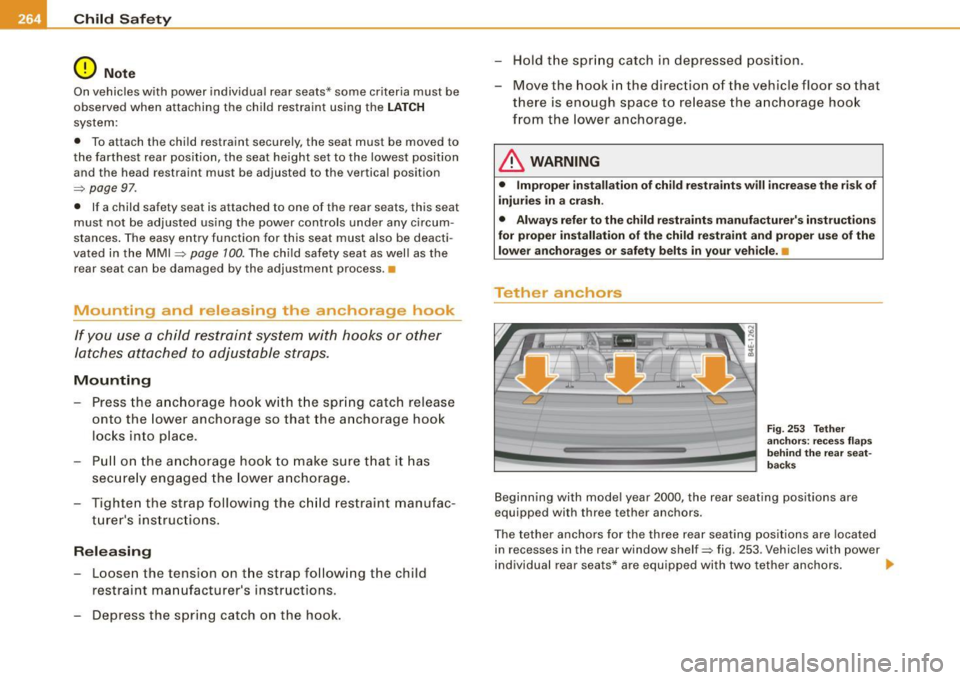
1111 Child Safety
---------..!...--------------------------------------
0 Note
On vehicles with power individual rear seats* some criteria must be
observed when attaching the child restraint using the
LATCH
system :
• To attach the child restraint securely, the seat must be moved to
the farthest rear position, the seat height set to the lowest position
and the head restraint must be adjusted to the ver tical position
~ page 97.
• If a child safety seat is attached to one of the rear seats, this seat
must not be adjusted using the power controls under any circum
stances. The easy entry function for this seat must also be deacti
vated in the
MMI ~ page 700. The child safety seat as well as the
rear seat can be damaged by the adjustment process .•
Mounting and releasing the anchorage hook
If you use a child restraint system with hooks or other
latches attached to adjustable straps.
Mounting
-Press the anchorage hook with the spring catch release
onto the lower anchorage so that the anchorage hook
locks into place .
- Pull on the anchorage hook to make sure that it has
securely engaged the lower anchorage.
- Tighten the strap following the child restraint manufac
turer's instructions.
Releasing
- Loosen the tension on the strap following the child
restraint manufacturer's instructions .
- Depress the spring catch on the hook. -
Hold the spring catch in depressed position.
- Move the hook in the direction of the vehicle floor so that
there is enough space to release the anchorage hook
from the lower anchorage.
& WARNING
• Improper installation of child restraints will increase the risk of
injuries in a crash.
• Always refer to the child restraints manufacturer's instructions
for proper installation of the child restraint and proper use of the
lower anchorages or safety belts
in your vehicle. •
Tether anchors
Fig. 253 Tether
anchors: recess flaps
behind the rear seat
backs
Beginning wi th model year 2000 , the rear seating positions are
equipped with three tether anchors .
The tether anchors for the three rear seating positions are located
in recesses in the rear window shelf~ fig. 253 . Vehicles with power
individual rear seats* are equipped with two tether anchors. .,.
Page 267 of 408
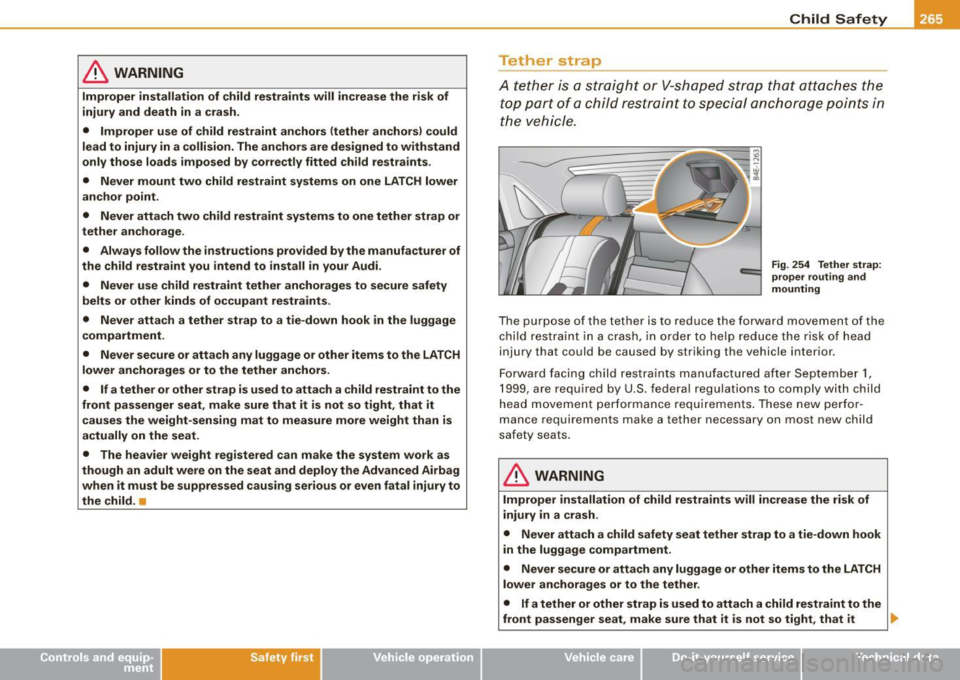
& WARNING
Improper installation of child restraints will increa se the r is k of
injury and death in a crash .
• Improper use of child restraint anchors (tether anchors) could
lead to injury in a colli sion. The anchor s are designed to withstand
only tho se load s impo sed by correctly fitted child restraints .
• Never mount two child restraint systems on one LATCH lower
anchor point .
• Never attach two child restraint sy stems to one tether strap or
tether anchorage .
• Always follow the instructions provided by the manufacturer of
the child restraint you intend to install in your Audi .
• Never use child restraint tether anchorages to secure safety
belts or other kinds of occupant restraint s.
• Never atta ch a tether strap to a tie -down hook in the luggage
compartment.
• Never secure or attach any luggage or other items to the LATCH
lower anchorages or to the tether anchors .
• If a tether or other strap is used to attach a child restraint to the
front passenger seat , make sure that it is not so tight , that it
c auses the weight -sensing mat to measure more weight than is
actually on the seat.
• The heavier weight registered can make the system work as
though an adult were on the seat and deploy the Advanced Airbag
when it must be suppressed causing serious or even fatal injury to
the child. •
Safety first
Child Safety
Tether strap
A tethe r is a straight or V-sh aped s trap t hat at taches the
top part of a chil d re str aint to s peci al anc ho ra ge poin ts in
t h e vehicle.
Fig . 254 Tether strap:
prope r routing and
mounting
The p urpose of the tether is to reduce the forward movement of the
c hi ld r estraint in a crash, in orde r to he lp redu ce th e risk o f head
injury that could be caused by striking the vehicle interior.
F o rw ard facing c hild res train ts manufact ure d after Sep te mb er 1,
1999, are required by U.S . federal re gulations to comply with child
head m ovement performance requ iremen ts . These new pe rfo r
mance requirements make a tether necessary on most new child
safety seats .
& WARNING
Improper installation of child restraints will increase the risk of
injury in a crash .
• Never attach a child safety seat tether strap to a tie -down hook
in the luggage compartment .
• Never secure or attach any luggage or other items to the LATCH
lower anchorages or to the tether .
• If a tether or other strap is used to attach a child restraint to the
front passenger seat, m ake sure that it is not so tight , that it •
I .
Vehicle care I I irechnical data
Page 268 of 408

___ C_h_ i_ld _ S_ a_ f_ e_ t-= y'------------------------------------------------
& W ARNING (continued )
causes the weight-sensing mat to measure more weight than is
actually on the seat.
• The heavier weight registered can make the system work as
though an adult were on the seat and deploy the Advanced Airbag
when it must be suppressed causing serious or even fatal injury to
the child .•
Using tethers on rear-facing child restraint
systems
Currently, few rear -facing child restraint systems come with a tether.
Please read and heed the child rest raint sy stem manufactu rer's
instruct ions ca reful ly to determine how to properly insta ll the
tether .
& WARNING
A child in a rearward -facing child safety seat installed on the front
passenger seat will be ser iously injured and can be killed if the
front airbag inflates - even with an Advanced Airbag System .
• The inflating airbag will hit the child safety seat or infant
carrier with great force and will smash the child safety seat and
child against the backrest , center arm rest , or door .
• A tight tether or other strap on a rearward -facing child restraint
attached to the front passenger seat can put too much pressure
on the weight -mat in the seat and register a heavier weight in the
Advanced Airbag System. The heavier weight registered can make
the system work as though an adult were on the seat and deploy
the Advanced Airbag when it must be suppressed caus ing serious
or even fatal injury to the child .
• If you must install a rearward facing child safety seat on the
front passenger seat because of exceptional circumstances and
the PASSENGER AIR BAG OFF l ight does not come on and stay on,
& WARNING (continued)
immediately install the rear-facing child safety seat in a rear
seating po sition and have the airbag system inspected by your
Audi dealer . •
Secur ing the upper tether strap to the anchor
bracket
F ig . 255 Tether strap:
proper routing and
mounting
Securing the child restraint tether strap to the
tether anchor
Re lease or dep loy the tether strap o n the chil d restraint
acco rdin g to th e ch ild restraint manufacturer 's usage
inst ructio ns.
Gu ide th e u pper tether stra p
under th e r ear he ad
rest rai nt=> fig. 255 (r ais e t he hea d rest raint if nece ssa ry).
- Tilt th e re cess flap -detail view- => fig . 255 up to exp ose
t he anch or b rack et.
Slide t he tet her strap h ook ove r th e an ch o r br acket .
Pull on the te the r st ra p h ook so that the sp rin g ca tc h of
th e ho o k e ngag es . .,.
Page 269 of 408
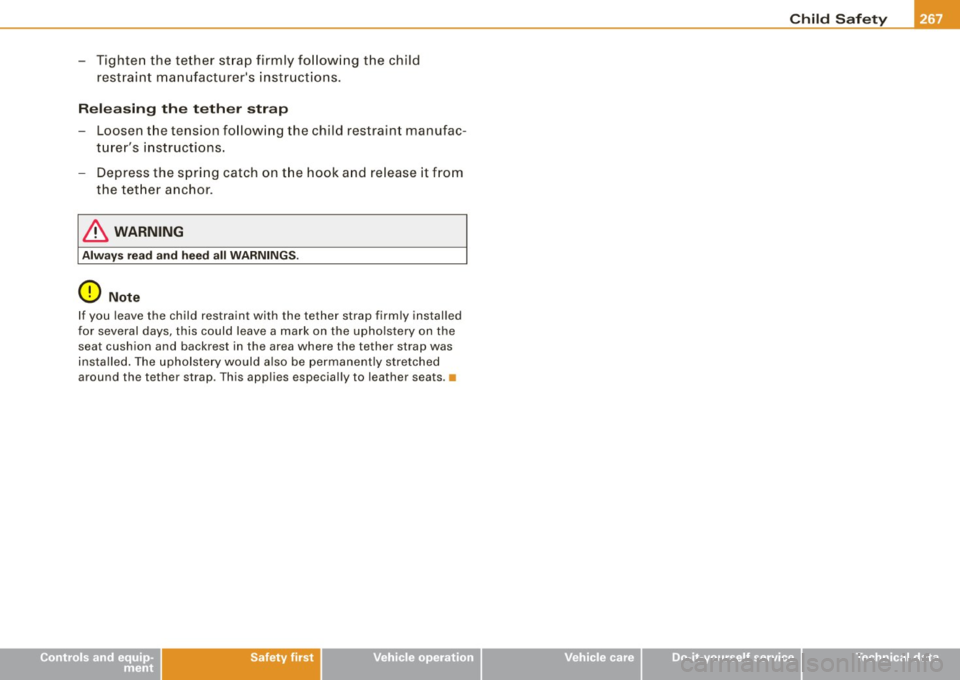
_____________________________________________ C_ h _ il_d _S_ a _ fe_t---= y'----"'
- Tighte n the te th e r st rap firml y fo llow ing t he child
r e st raint ma nufactur er's instr uct ions.
Releasing th e tether strap
- Loosen t he tension fo llowing the child restra int manufac
t u re r's instructions.
- Depress the spr ing catch on t he hook a nd re lease it f rom
the tet her anchor .
& WARNING
Always read a nd heed all WARNINGS .
0 Note
If you leave the child restraint with the tether strap firm ly instal led
for several days, this could leave a mark o n the upho lstery on t he
seat cushion and backrest in the area where the tether strap was
installed . The upholste ry would a lso be permanen tly s tretched
around the tether strap . This applies especially to leather seats .•
Controls and equip
ment Safety first Vehicle operation
Vehicle care Do-it-yourself service Technical data
Page 270 of 408
